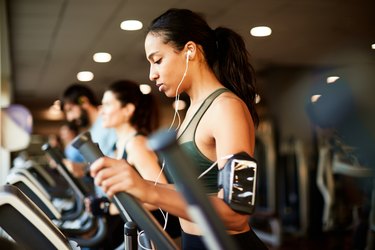

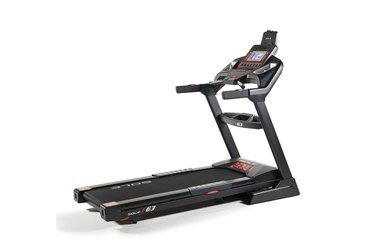
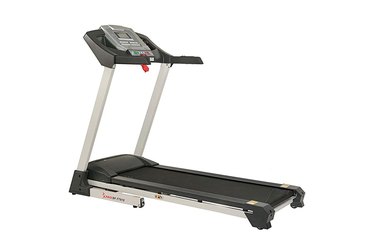
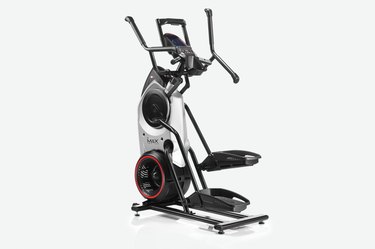
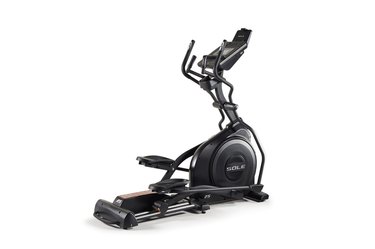
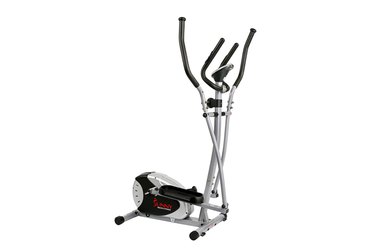

Walking and using the elliptical are two of the most popular forms of low-impact cardio. They're both easy on the joints, burn calories and help you build muscle. But if you have to choose, which is one is a better workout: the elliptical or walking?
It depends on your fitness goals and what you want to achieve. Here's what you should consider when weighing the elliptical versus walking.
Video of the Day
Video of the Day
Which Burns More Calories?
Walking and the elliptical are both cardio workouts, so naturally, they burn calories. But exercising on an elliptical typically burns more calories than walking, due to the increased resistance.
A 155-pound person can burn around 335 calories after 30 minutes of working out on the elliptical, according to Harvard Health Publishing. The same person burns only around 149 calories after 30 minutes of walking.
That said, you can increase your calorie burn from walking if you pick up the pace or add some resistance on your route, like walking up a hill. Gauge your rate of perceived exertion (RPE): Are you breathing heavy? Are you sweating? If the answer is no, you can dial things up.
However, it's important to note that there are many different factors that go into how many calories you'll ultimately burn during your workout, explains Kelvin Gary, CPT, a certified personal trainer and founder of Body Space Fitness in New York City.
For example, your basal metabolic rate (the number of calories you burn at rest), non-exercise activity thermogenesis (or NEAT — energy expended during basic movement and walking around) and the thermic effect of food (the rate at which you burn calories after eating) can all contribute to the number of overall calories you'll burn while walking or exercising on the elliptical.
"Non-exercise basic movement is the second-largest source of energy, so when you're considering which activity is a better workout [for burning calories], you have to take into account a lot more than just what you're doing in that single workout," Gary says.
Winner: Elliptical
Related Reading
Which One Is Easier on the Joints?
While walking is by no means a high-impact activity, your joints do absorb some impact as you lift one foot at a time and make contact with the ground with each step. Over time, this can weigh on the joints, especially if you're walking on inclines or uneven surfaces or at different speeds.
But when you're working out on the elliptical, your feet never leave the surface, so your joints won't absorb any impact from landing.
"The elliptical is lower impact because you have less ground contact, so there's less force absorption by the body and joints," Gary says.
Winner: Elliptical
Which One Is Best for Weight Loss?
If your goal is to solely lose weight, the workout that you'll do more consistently is the best one for you, says Liz Van Voorhis, CPT, a certified personal trainer and founder and CEO of Fit Collective in New York City.
"Even though you might be able to hop on the elliptical and go for an hour and burn a ton, I think walking is a better option because it's easier and more accessible — you can do it with or without a machine," Gary says.
"NEAT is the second-largest source of total calorie expenditure, and diet, rest, de-stressing and recovery also play a large role in weight loss. So it's a bit of a trick question."
But Gary agrees with Van Voorhis that the best workout for weight loss is the exercise you will do most frequently.
Winner: Tie
Which Builds More Muscle?
"Building muscle is created through resistance," Van Voorhis says, and because the elliptical has different resistance settings you can easily adjust, it might be the better option of the two.
However, walking on an incline outside or on a treadmill can also add resistance to your cardio workout, so both modalities can help you achieve some muscle strength.
The bottom line, though, is if you want to increase muscle mass and improve strength, you should consider adding some actual load to your routine through dumbbells, kettlebells, resistance bands and other strength-training equipment.
Winner: Tie
Which One Is Ideal for a Full-Body Workout?
Both the elliptical and walking are primarily lower-body exercises, but you can get your upper body involved on the elliptical.
"If you utilize the arm handles on the machine, pushing and pulling against the resistance, you're incorporating your arms, shoulders, back and core, in addition to your legs," Van Voorhis says. For this reason, the elliptical is more ideal for a full-body burn.
But you can add abs and arms to your walking workout by engaging your obliques, forming a fist and holding your arms at 90-degree angles or using walking poles. Avoid walking with hand weights because they can put additional stress on your elbows and shoulders, according to the American Heart Association.
Instead, try walking with a backpack or weighted vest. At 10 or 15 percent of your body weight, those options can increase overall calorie expenditure because you're recruiting more muscle groups in your exercise, according to the American Council on Exercise (ACE).
Just make sure to consult your doctor or a certified trainer before incorporating a weighted vest into your walking workouts to avoid making certain conditions — like arthritis, low-back pain and osteoporosis — worse.
Winner: Elliptical
Which One Is Best for Heart Health?
Any aerobic workout generally improves heart health because it contributes to healthy blood pressure and cholesterol, according to the National Heart, Lung and Blood Institute; both exercising on the elliptical and walking fit the bill.
"To improve cardiovascular health, the type of training I recommend is interval training. Alternating periods of higher output and lower output allows your heart to take on stress and recover quickly," Van Voorhis says.
While interval training can be done walking or on an elliptical, walking has an edge over the elliptical because you can easily transition to higher intensity — even running, and your heart works harder while running because it demands more oxygen.
"Personally, I prefer walking in this circumstance because when you are ready, you may be able to add a jog, or a run or a sprint, and alternate those bursts with walking," Van Voorhis says. "You can start with 30 seconds or 1 minute of alternating between higher and lower intensities."
Gary sides with walking for cardiovascular activity, too, explaining that folks who aren't able to walk as much or as far can instead maximize their workout at a higher intensity to make walking an effective cardiovascular workout.
Winner: Walking
Which One Costs Less?
Walking is the less expensive workout because all you'll need is a pair of supportive sneakers, whereas buying an elliptical can cost upwards of $3,000, while a gym membership can average more than $500 a year.
However, if you decide to purchase a treadmill for walking, you can find a good-quality, affordable one for under $1,000. Depending on what type of high-tech features are included in your treadmill, the price can skyrocket. So, if you're buying a treadmill just for walking, consider the built-in apps and trackers and whether you really need them before purchasing.
Winner: Walking
So, Is the Elliptical Better Than Walking? Or Is Walking Better Than the Elliptical?
Using the elliptical and walking are both great cardio workouts, but the best option for you is the workout you enjoy and will do regularly to help you reach your goals. If you have goals of running a 5K, for instance, walking is a more suitable workout for you, but if you want to get a full-body, low-impact burn, the elliptical may be the way to go.
Here are three other things to keep in mind when choosing between the two:
1. Your Current Fitness Level and Health
"If you have injuries and medical issues that will be affected by the impact from a treadmill, then an elliptical is preferred," Gary says.
2. How Much Variation You Like
"You are somewhat limited in the potential progress with an elliptical relative to a treadmill," Gary says. "Incline, decline, speed and time are all things that can be better manipulated with a treadmill."
And if you're walking outside, you can track your progress by measuring time, speed and distance.
3. Who Else Might Use the Elliptical or Treadmill
If you're considering investing in a piece of equipment, it's worth thinking about if others in your home would use one or the other, says Van Voorhis. The best machine for you is one that gets the most use.
The Bottom Line
Gary and Van Voorhis both think that the treadmill might be a better option, if pressed to choose. "It more closely replicates real life, and teaches you to have a relationship with gravity, which is important," Gary says.
Van Voorhis agrees that everyone should adopt a walking habit. "Waking more will make you healthier in general, too," she says.
The 3 Best Treadmills for Your Home Gym
1. NordicTrack Elite Treadmill
This treadmill has all the bells and whistles, including a swivel screen and auto-adjusting metrics. It goes up to a max 40 percent incline and 5 percent decline, so you can replicate all different types of terrain and routes. NordicTrack pairs with the iFit app, an expansive library of workouts from elite trainers, which you can stream on the 22-inch HD screen.
Buy it: Nordictrack.com; Price: $3,499
2. Sole Fitness F63 Treadmill
Prop your tablet up on the top of this machine, or just monitor your stats like speed, incline, total time, distance, pace and calories burned on the display. The machine has bluetooth-connected speakers so you can blast your favorite workout music as you choose from 15 different incline levels and six programs.
Buy it: Soletreadmills.com; Price: $1,199
3. Sunny Health and Fitness SF T7515 Smart Treadmill
This budget pick has super-accessible speed and incline buttons on the arms of this treadmill that make it easy to adjust the intensity of your workout mid-walk. It has a water-bottle holder, and it can track your time, distance, speed, calories, incline (0 to 12 percent) and heart rate. And at less than 6 feet long, it has a small footprint perfect for tight spaces.
Buy it: Amazon.com; Price: $529
The 3 Best Ellipticals for Your Home Gym
1. Bowflex Max Trainer M6
With more than 5,000 five-star reviews, this elliptical is a favorite of many. It has 16 levels of resistance and sets target burn rates to help you achieve your cardiovascular and weight-loss goals.
Buy it: Bowflex.com; Price: $1,499
2. Sole Fitness E25 Elliptical
You can stay cool no matter how long you work out, thanks to the built-in water-bottle holder and cooling fan. Adjust the custom-designed foot pedal to fit you, and choose from 20 different resistance levels. The bluetooth audio speakers allow you to plug in your smart device.
Buy it: Soletreadmills.com; Price: $1,099
3. Sunny Health and Fitness SF-E905 Elliptical
If you're looking for an elliptical that's more compact, this one has a much smaller console and doesn't take up nearly as much space as the other two on this list. But it doesn't skimp on the basic features: This no-frills elliptical has eight levels of resistance and built-in trackers to monitor your heart rate, speed, time, distance and calories.
Buy it: Kohls.com; Price: $228.99
- Harvard Health Publishing: "Calories Burned in 30 Minutes for People of Three Different Weights"
- American Heart Association: "Why Is Walking the Most Popular Form of Exercise?"
- American Council on Exercise: "Improve Walking Workouts With Weighted Vests"
- National Heart, Lung and Blood Institute: "Physical Activity and Your Heart"
Was this article helpful?
150 Characters Max
0/150
Thank you for sharing!
Thank you for your feedback!